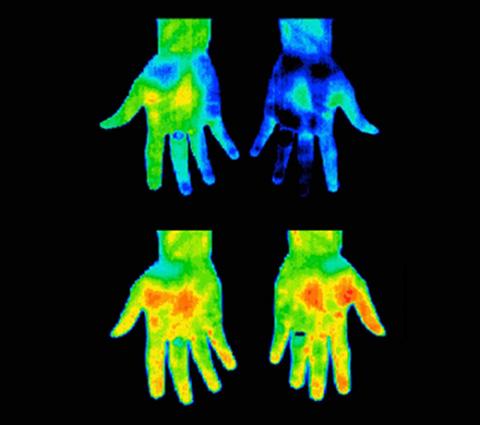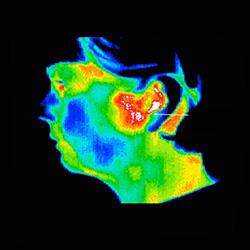
Non-Invasive Screening
Digital Infrared Thermal Imaging has been in use in the United States, Europe, and Japan for over 25 years in the diagnosis and treatment of vascular disorders, pain, surgery, tissue viability, and monitoring the efficiency of drugs and therapies. It's a non-invasive process that is a sensitive and reliable means of graphically mapping and displaying skin surface temperature. Thermography can be used to diagnose, evaluate, monitor and document a large number of injuries and conditions, such as:
- Arthritis
- Back Injuries
- Breast Disease
- Cardiac Dysfunction
- Carpal Tunnel Syndrome
- Dental and TMJ
- Diabetes
- Digestive Disorders
- Disc Disease
- DVT
- Epicondylitis
- Fibromyalgia
- Headaches
- Inflammatory Pain
- Limb Ischemia
- Muscle Injuries
- Nerve Damage
- Raynaud’s Disease
- RSD (CRPS)
- Skin Cancer
- Sprain/Strain
- Stroke Screening
- Synovitis of Joints
- Tendon Sheaths
- Unexplained Pain
- Vascular Disease
- Whiplash
Reading Thermal Scans
Thermographic scans can graphically display the very subjective feeling of pain by objectively displaying the changes in skin surface temperature that accompany pain states. Thermal abnormalities are present in a number of diseases and physical injuries that can be detected non-invasively by thermography. It is used as an aid for diagnosis and prognosis, as well as therapy follow up and rehabilitation monitoring within clinical fields that include rheumatology, neurology, physiotherapy, sports medicine, oncology, pediatrics, orthopedics and many others. Results obtained with DITI systems are totally objective and show excellent correlation with other diagnostic tests.
An infrared scanning device is used to convert infrared radiation emitted from the skin surface into electrical impulses that are visualized in color on a monitor. This visual image graphically maps the body temperature and is referred to as a thermogram. The spectrum of colors indicate an increase or decrease in the amount of infrared radiation being emitted from the body surface. Since there is a high degree of thermal symmetry in the normal body, subtle abnormal temperature asymmetries can be easily identified. DITI can show a combined effect of the autonomic nervous system and the vascular system, down to capillary dysfunctions. The effects of these changes show as asymmetries in temperature distribution on the surface of the body.


Reliable Diagnostic Tool
Hindsight Themography conducts testing under the guidelines established by the American Academy of Thermology, including clinic controls, recording of historical and clinical data (personal health information) related to the test being conducted, establishing thermal equilibrium, image capture and challenging thermal equilibrium when indicated.
DITI has been recognized as a viable diagnostic tool since 1987 by the AMA council on scientific affairs, the ACA council on Diagnostic Imaging, the Congress of Neurosurgeons in 1988 and in 1990 by the American Academy of Physical Medicine and Rehabilitation. Its use in breast health assessment as well other medical assessments are well documented with over 800 per reviewed studies.
